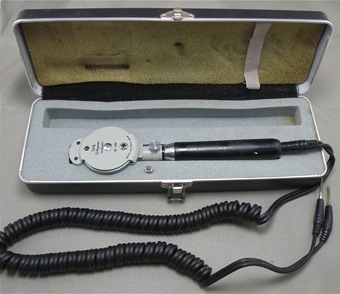Neitz Euthyscope ophthalmoscope, cased
Catalogue Number: 3538 Neitz Euthyscope ophthalmoscope, cased Category: Equipment Sub-Category: Ophthalmoscope Year Of Publication/Manufacture: c1960 Time Period: 1940 to 1999 Place Of Publication/Manufacture: Tokyo, Japan Publisher/Manufacturer: Neitz Co Description Of Item: Ophthalmoscope designed for the treatment of amblyopia and eccentric fixation using the methods of pleoptics. Grey plastic and metal head attached to slim black handle and coiled black power leads. Head has one main wheel of lenses, 5 fixation targets and a small supplementary function wheel with +10 and -10 lenses and a green filter. Head is marked in black 'Neitz Euthyscope/ PAT. 549417/ No 4161/ NEITZ CO., TOKYO JAPAN'. Fitted metal case covered in black vinyl. 2 spare globes in a small cardboard box. Instrument: 170 x 42 x 20 mm without lead. Case: 245 x 45 x 80mm. Historical Significance: Pleoptics is an alternative system of methods for the treatment of amblyopia and eccentric fixation. It was devised in 1947 by Alfred Bangeter (1909-2002), a Swiss ophthalmologist who was head of the Eye Department in St-Gallen from 1946 to 1983. He actively promoted his methods at conferences, in publications and through a School of Pleoptics and Orthoptics that he created. The method used bright light to desensitise the region of the retina used for eccentric fixation and the stimulation of the true fovea with flashing lights. and other methods. Bangeter devised some 20 instruments for providing pleoptic treatment. His contemporary, Curt Cuppers, (1910-1995), a German ophthalmologist, was equally inventive in producing instruments, of which this item is one example. However, pleoptics did not hold to its initial promise and interest in it declined during the 1960s. See Priestley BS. Pleoptics instruments and methods. Int Opthal Clinics 1961; 1: 787-827 for a detailed account of pleoptic instruments. How Acquired: Donated by Leo Hartley Date Acquired: Oct 2004 Condition: Instrument good, case lining decayed Location: Archive Office. Cabinet One Drawer 13 |


